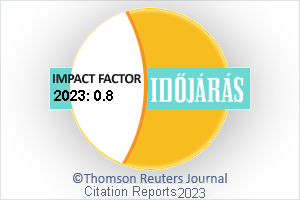IDŐJÁRÁS - angol nyelvű folyóirat
Vol. 120, No. 3 * Pages 267–351 * July - September 2016
 |
|
Overview of the tropospheric ozone problem: formation, measurements, trends, and impacts (Hungarian specialties)
Zita Ferenczi and Kornélia Imre
idojaras.2016.3.1 (p. 267–)
Zita Ferenczi and Kornélia Imre
idojaras.2016.3.1 (p. 267–)
Intra-urban temperature observations in two Central European cities: a summer study
Enikő Lelovics, János Unger, Stevan Savić, Tamás Gál, Dragan Milošević, Ágnes Gulyás, Vladimir Marković, Daniela Arsenović, and Csilla V. Gál
idojaras.2016.3.2 (p. 283–)
Enikő Lelovics, János Unger, Stevan Savić, Tamás Gál, Dragan Milošević, Ágnes Gulyás, Vladimir Marković, Daniela Arsenović, and Csilla V. Gál
idojaras.2016.3.2 (p. 283–)
Short-term weather fluctuation and quality assessment of oxbows
János Tamás Kundrát, Edina Simon, István Gyulai, Gyula Lakatos, and Béla Tóthmérész
idojaras.2016.3.3 (p. 301–)
János Tamás Kundrát, Edina Simon, István Gyulai, Gyula Lakatos, and Béla Tóthmérész
idojaras.2016.3.3 (p. 301–)
Comparison of simulated and objectively analyzed distribution patterns of snow water equivalent over the Carpathian Region
Hristo Chervenkov and Kiril Slavov
idojaras.2016.3.4 (p. 315–)
Hristo Chervenkov and Kiril Slavov
idojaras.2016.3.4 (p. 315–)
Climate-based seasonality model of temperate malaria based on the epidemiological data of 1927–1934, Hungary
Attila Trájer and Tamás Hammer
idojaras.2016.3.5 (p. 331–)
Attila Trájer and Tamás Hammer
idojaras.2016.3.5 (p. 331–)
IDŐJÁRÁS folyóirat

Az IDŐJÁRÁS a HungaroMet Nonprofit Zrt. negyedévenként megjelenő angol nyelvű folyóirata
Megrendelhető a journal.idojaras@met.hu címen.
A szerzőknek szánt útmutató itt olvasható.
Megrendelhető a journal.idojaras@met.hu címen.
A szerzőknek szánt útmutató itt olvasható.









